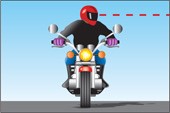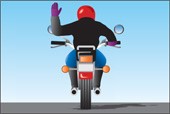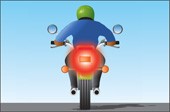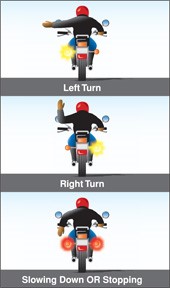Communicating with other drivers
In addition to seeing and being seen, it is important to communicate with other drivers to make sure they see you and know what you are doing. Make eye contact with other drivers. Check over your shoulder often to make sure other drivers are not crowding you.
Be ready to use your horn, if necessary, before you pass a vehicle, or approach a driveway or intersection where a vehicle may pull out in front of you. You can use your horn before passing a vehicle you think might move into your lane. Watch for situations such as a driver in the lane next to you coming up behind a vehicle; a parked car with someone in it; or someone walking or riding a bicycle on the road.

Use your signals to communicate. A driver behind you is more likely to understand your turn signal than your tail light. Use your turn signals even when what you plan to do is obvious. For example, if you use your signals on a freeway entrance ramp, it is more likely that vehicles on the freeway will see you and make room for you. Also, signal whenever you change lanes whether someone else is around or not. It is when you do not see the other vehicle that your signals are most important.

Remember to turn off your signal after you have completed your turn or lane change. It can be as dangerous to forget to turn a signal off as it is to forget to turn it on. A driver may think that you plan to turn or make a lane change. Check your instrument panel to see if you have left a signal on. If you have an older model vehicle that did not come with turn signals, use the standard hand and arm signals as shown in the diagrams here. This also applies if your turn signals or brake lights are not working, in which case you should proceed to take your vehicle off the road until repairs can be made. Manual hand and arm signals are less effective during poor light conditions and may not be visible to others. Exercise extra caution if your turn signals and brake lights are not working.
When watching for signals made by others, remember that cyclists may signal right turns by holding their right arm straight out.

Tap the brake pedal lightly to flash your brake light before you slow down. This warns drivers behind you that you are going to slow down. This is especially important when you are being followed too closely, when you are making a tight turn off a high-speed road, or when you are slowing down or turning where others may not expect it. Also, keep your foot on the brake, day or night, when stopped for a stop sign or traffic signal.


Summary
By the end of this section, you should know:
- How to use eye contact and your horn to communicate with other road users
- How to use signals and brake lights to communicate your intentions to other road users